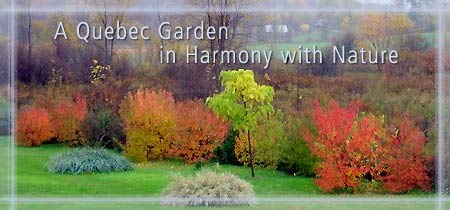
|
Photo: Hamiza Bakirci By Sarah CoulberWhen Svetlana and Vadim Fotinov bought their current home, they had big plans. They were moving from their condo in downtown Ottawa, Ont., to a one-acre property across the river in Luskville, Que. This gave them a chance to create an Arts and Crafts garden, “having roots in the gardens of the Arts and Crafts movement of the 19th and 20th centuries, yet reflecting current times,” Svetlana explains. Unlike formal gardens of the Victorian era, the Arts and Crafts movement “created gardens in harmony with nature, using local materials when constructing architectural components, emphasizing local plants, and celebrating regional rhythms and materials,” says Svetlana. The style perfectly suits their goal of giving back to wildlife at a time when ecosystems are under stress from development and climate change. The result, five years later, is their EcoGarden. The once-bare expanse of lawn is now dotted with more than 300 trees, shrubs, herbaceous perennials and ornamental grasses, most of which are native. These plants have lured back the local wildlife, providing them with necessary shelter and food. The Fotinovs ensure these benefits are present in all seasons by growing plants such as willows that flower in the early spring and asters that bloom into the fall. This means that precious pollen and nectar are available for beneficial insects, birds and more, as they arrive or return to the area, grow, have babies, and then get ready to hibernate or migrate for the winter months. For those creatures that remain and are active in the winter, the Fotinovs don’t cut back their plants in the fall, which allows late-blooming flowers to form seeds and fruit and to provide shelter from the winter cold. Although the Fotinovs’ gardening practices help many creatures, including flying squirrels, frogs, birds and bats, they give special thought to species that they want to attract. For instance, they grow plants for adult butterflies (milkweed, coneflowers, lupines and asters) and for their caterpillars (willows, milkweed, violets, dogwoods, parsley and viburnums). Delighted to watch the different stages of the butterflies’ life cycles, the Quebec couple provides the appropriate habitat through the seasons. Other plants, such as bee balm, obedient plant, apple blossoms, columbine and the cardinal flower, are planted to attract hummingbirds. While they do have hummingbird feeders, the Fotinovs want to create habitat that fulfils much of the hummingbirds’ needs naturally. Their plants and their commitment to using alternatives to pesticides and chemical fertilizers help to attract and protect another component of the hummingbirds’ dietary needs — spiders and small insects, which provide protein and form approximately 20 percent of their diet. For birds, the Fotinovs planted various berry bushes including highbush cranberry, black chokeberry, hawthorns and dogwoods. The birds enjoy these and many other plants found in their EcoGarden — for seeds, fruit and insects, shelter from the elements and predators, as well as a place to nest. Another element of their garden is water. Essential to wildlife, Svetlana and Vadim have several water dishes around the property. Some of these are for birds but they also have some set up specially for other wild visitors. The dishes with wet sand are designed for butterflies and moths that get minerals in their diets this way. Other water dishes are shallow with small stones for perching dragonflies and other beneficial insects. In keeping with their goal of harmonizing with the landscape, the Fotinovs use natural materials such as “boulders hollowed by water and rocks and flat stones for butterflies and dragonflies to bask in the sun.” As part of their environmental dedication, the Fotinovs use a rain barrel. They even resorted to using their chemical-free swimming pool to collect rain water when they were establishing plants. Natural soil amendments, such as compost, are used in their garden, thanks in part to the compost they make from kitchen and garden scraps. The Fotinovs never water their lawn and refrain from using pesticides. Their efforts certainly impressed one neighbour, who, after buying the adjacent property in 2003, saw how hard they were working to restore the landscape. They then “decided to leave nearly 50 percent of their one-acre lot in its natural state of trees, meadow plants and grasses,” recounts Svetlana. The Fotinovs’ property is a perfect spot to pursue their other interests. Svetlana’s background as an educator and Vadim’s as a journalist have in common a passion for understanding the natural world and sharing what they learn with others. A natural outcome of this was their production of educational videos on the monarch butterfly. Having lots of common milkweed, the monarch’s favourite plant, gave them the perfect opportunity to observe and film this lovely creature. The next step, according to Svetlana, is to convert the lawn. “With nearly all structural components (trees, shrubs) now in place and areas well defined (bird garden, butterfly garden, hummingbird garden), it is time to replace the greater part of the lawn — a huge area — with meadow grasses and perennials appropriate for local conditions and useful for wildlife. We have already begun this work and planted goldenrod and New England asters. We rescued these plants when road construction crews were widening rural roads. Goldenrod, asters and Joe-Pye weed are beautiful additions to any garden, and butterflies and bees find them irresistible in late summer and fall.” Banner photo: Svetlana Fotinov
| ||






